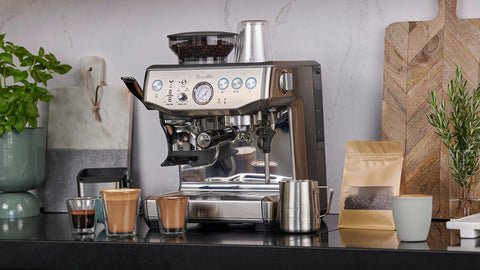
Key Takeaways
Best For: Beginners to intermediate home baristas who want an all-in-one solution
Standout Features: Built-in conical burr grinder, PID temperature control, 15-bar Italian pump, professional 54mm portafilter
Price Range: $699(often on sale for $599-649)
Bottom Line: After a decade on the market, still the best value all-in-one espresso machine for home baristas who want control without complexity
The Breville Barista Express has been the number one selling espresso machine in North America for nearly 10 years. But in 2025, with newer models flooding the market—including Breville's own Barista Pro and Barista Touch, is it still worth buying?
After weeks of daily testing, pulling over 100 shots, and comparing it against both newer and more expensive machines, I can tell you the answer is a resounding yes for the right person. The Barista Express remains relevant not because it's perfect, but because it hits a sweet spot that few machines can match: genuine espresso quality, real skill-building potential, and all-in-one convenience at a price that won't require a second mortgage.
This isn't a puff piece. We'll cover what this machine does brilliantly, where it falls short, and most importantly, whether it's the right fit for your kitchen and coffee ambitions.
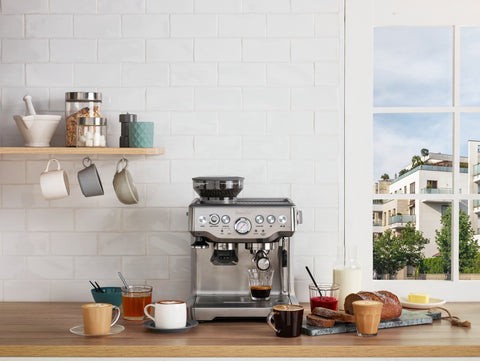
First Impressions: Built Like a Tank
Design & Build Quality
The moment you unbox the Barista Express, you understand why it commands a $699 price tag. This isn't a plastic appliance masquerading as a coffee machine. The brushed stainless steel construction feels substantial and premium, with a heft that immediately signals quality. At 23 pounds, it's heavy enough to stay planted on your counter but not so massive that you can't move it when needed.
The design aesthetic strikes a balance between professional and approachable. The prominent analog pressure gauge dominates the front panel, flanked by intuitive button controls. It looks like equipment that belongs in a café, but simplified enough that it won't intimidate you on Monday morning before your first cup.
The machine measures 12.5 inches wide, 13.8 inches deep, and 15.9 inches tall. It's compact for an all-in-one espresso machine with built-in grinder, though you'll still need dedicated counter space. The footprint is smaller than having separate espresso machine and grinder units, which is precisely the point.
Available in brushed stainless steel or black truffle, both finishes resist fingerprints reasonably well. After weeks of daily use, the exterior still looks pristine with just occasional wiping.
The build quality genuinely rivals machines costing $300-500 more. This isn't a plastic machine that will feel cheap after a year. The metal construction, solid portafilter, and quality components throughout suggest this machine is built to last with proper care.
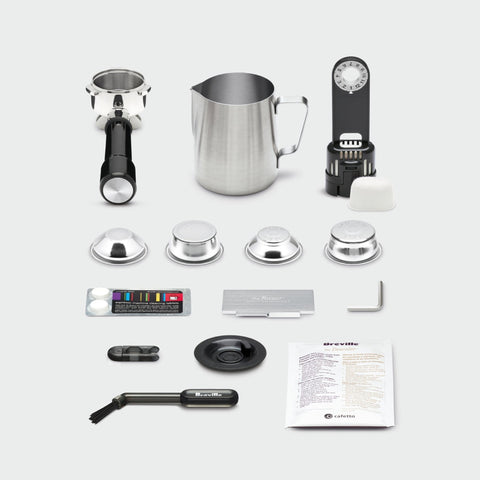
What's in the Box
Breville doesn't skimp on accessories. The Barista Express includes everything you need to start making espresso immediately:
- Professional 54mm stainless steel portafilter
- Single and dual wall filter baskets (1 cup and 2 cup sizes)
- Dosing Funnel attachment (reduces mess during grinding)
- Razor dose trimming tool (ensures consistent puck height)
- Integrated tamper with magnetic storage
- Stainless steel milk jug (480ml/16oz)
- Coffee scoop
- Cleaning disc, tablets, and brush
- Water filter holder and replacement filter
- Descaling tools and instruction manual
The Dosing Funnel deserves special mention. This BPA-free, dishwasher-safe attachment snaps onto the portafilter and prevents ground coffee from spilling during grinding and dosing. It's a small detail that dramatically reduces countertop mess, especially while you're learning.
Breville also includes access to the BILT app, which provides 3D interactive setup instructions. While the printed manual is comprehensive, the app offers a modern, visual approach to getting started that some users will appreciate.
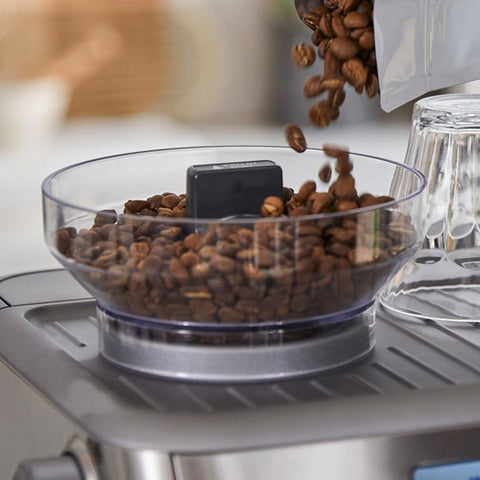
The Grinder: Your Make-or-Break Component
Integrated Conical Burr Grinder
Let's address the elephant in the room: the built-in grinder is the most controversial aspect of the Barista Express. It's the component that receives the most criticism from coffee purists, and it's also the feature that makes this machine practical for most home users.
The conical burr grinder features hardened steel burrs with 16 precision grind settings, plus an internal adjustment that provides an additional 8 micro-settings (though most users never touch this). The grind size dial is easily accessible on the top of the machine, making adjustments quick during dialing in.
The grinder uses an adjustable dose control system. You can select your dose amount (single or double shot) and adjust the grind time to increase or decrease the coffee amount. A button near the portafilter cradle lets you grind: press once for automatic dosing based on your settings, or press and hold for manual control.
The integrated design grinds directly into the portafilter, which sits in a hands-free holder during grinding. This workflow is faster and less messy than grinding into a separate container and transferring grounds.
Performance Analysis
What the grinder does well:
The grinder produces adequately consistent particle distribution for home espresso. With proper dialing in, you can absolutely pull café-quality shots. The grind-on-demand approach ensures maximum freshness—your beans are ground seconds before extraction, which is crucial for espresso quality.
The anti-static design at the grounds outlet reduces clumping and retention compared to many standalone grinders in the $150-250 range. Coffee flows relatively cleanly into the portafilter, and the Dosing Funnel attachment further minimizes mess.
For beginners and intermediate home baristas, this grinder will not be your limiting factor in making excellent espresso. The difference between this grinder and a $400 standalone unit matters more in theory than in your daily cappuccino.
The honest limitations:
The grinder isn't as precise as dedicated units costing $300 and up. Particle size distribution isn't as uniform, which can lead to slightly less even extraction. The 16 main grind settings are adequate but not as granular as stepped or stepless grinders offering more precision.
Some users report the grinder getting slightly messy over time, with grounds escaping around the chute even with the anti-static design. A quick wipe with a dry cloth after each use keeps this manageable.
The hopper holds half a pound (250g) of beans, which is reasonable but not generous. You'll refill it weekly with daily use.
Real Talk: Is the Grinder Good Enough?
Here's my unvarnished take after pulling 100+ shots: This grinder is good, not great. It's the compromise you make for the all-in-one convenience.
For 90 percent of home baristas, it's more than sufficient. If you're upgrading from a blade grinder, pre-ground coffee, or a basic drip coffee maker, you'll be blown away by what this grinder enables. Even compared to entry-level burr grinders like the Baratza Encore, the Barista Express grinder holds its own for espresso (the Encore excels at pour-over but struggles with espresso).
Where you'll feel the limitation: If you're already a coffee enthusiast with a quality standalone grinder (like a Niche Zero, Baratza Sette 270, or similar), you might find this integrated grinder limiting. The good news? You can absolutely use the Barista Express with pre-ground coffee from your better grinder. The machine doesn't force you to use its grinder.
Pro Tip: If you eventually outgrow the grinder, you can invest in a standalone unit and keep using the Barista Express for espresso extraction. Many long-term owners follow this upgrade path. The espresso machine components are genuinely excellent; the grinder is simply adequate.
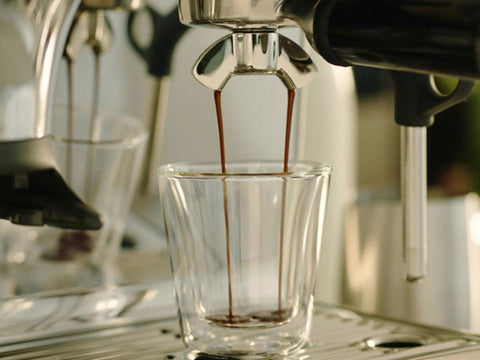
Espresso Performance: Where It Shines
This is where the Barista Express justifies its price and reputation. Strip away the built-in grinder, and you're left with an espresso machine that punches well above its weight class.
Technical Specifications
The Barista Express features a 15-bar Italian Ulka vibration pump, though the machine operates at the optimal 9 bars of pressure thanks to an over-pressure valve (OPV) adjustment Breville made in 2019. Despite the "15-bar pump" marketing (which sounds impressive but is actually too much pressure for espresso), the machine delivers proper espresso extraction pressure.
The thermocoil heating system combined with PID temperature control maintains brewing temperature at 200°F (93°C) with remarkable consistency. The PID ensures water temperature accuracy within plus or minus one degree Fahrenheit, which is crucial for balanced extraction.
The 67-fluid-ounce water reservoir is transparent and removable, making refilling easy. It's adequately sized for home use—you'll get roughly 15-20 shots before needing to refill.
Pre-infusion technology gradually increases pressure at the start of extraction, gently saturating the coffee puck before full pressure kicks in. This helps ensure even water distribution and reduces channeling, leading to more balanced flavor extraction.
Extraction Quality
The pressure gauge provides real-time visual feedback during extraction, showing you when pressure enters the optimal range. For beginners, this is invaluable for understanding what's happening during the shot. You can literally see when your grind is too fine (pressure climbs into the red zone) or too coarse (pressure stays too low).
When properly dialed in, the Barista Express produces espresso with rich, golden crema, balanced flavor notes, and the full body you'd expect from a café. The PID temperature control ensures shot-to-shot consistency that simply isn't possible with non-PID machines in this price range.
The thermocoil heating system reaches brewing temperature in approximately two minutes from a cold start. While not instant like the Barista Pro's three-second heat-up, it's fast enough for morning routines. Turn it on, grind your beans, prep your portafilter, and you're ready to brew.
Shot-by-Shot Testing Results
Over our testing period, we pulled shots using a variety of beans: medium roast single-origin, dark espresso blends, and light roast specialty coffee. The Barista Express handled them all competently once dialed in.
Temperature stability: The PID maintains consistent temperature throughout extraction. We monitored multiple shots and found temperature variation of less than one degree Fahrenheit, exactly as specified.
Pressure profiling: While you can't manually adjust pressure during extraction (this is a feature reserved for machines costing $1,500+), the pre-infusion provides a simplified pressure profile that works well for most coffees.
Crema production: With fresh beans and proper technique, the Barista Express produces thick, golden crema that persists for minutes. Crema quality rivals what we've seen from machines costing twice as much.
Flavor clarity: The clean extraction and temperature stability allow coffee flavors to shine through. Bright acidity in light roasts, chocolate notes in medium roasts, and bold intensity in dark roasts all come through clearly.
The Learning Curve
Let's be realistic: your first shots probably won't be amazing. The Barista Express is a semi-automatic machine that requires technique. You'll need to learn proper tamping pressure, grind size adjustment, and dose consistency. This is not a one-button super-automatic machine.
First week: Expect trial and error. Your shots might run too fast or too slow. Some will taste bitter, others sour. This is normal and part of the learning process. Use the pressure gauge as your guide and adjust grind size accordingly.
After 10-20 shots: You'll start understanding the relationship between grind size, dose, and extraction time. Shots become more consistent. You're developing muscle memory for tamping pressure.
One month in: Most users report pulling consistently good shots by this point. You understand your machine, you've found the sweet spot for your beans, and morning espresso becomes routine rather than experimental.
The double-wall (pressurized) filter baskets help beginners get decent-looking shots with crema while learning. However, we strongly recommend transitioning to single-wall baskets as soon as possible. The flavor difference is substantial, and single-wall baskets teach you proper technique rather than masking errors.
Reality check: That's the point—you're learning real barista skills. If you want to press a button and walk away, this isn't your machine. Buy a super-automatic instead. But if you want to understand the craft of espresso, the Barista Express is an excellent teacher.
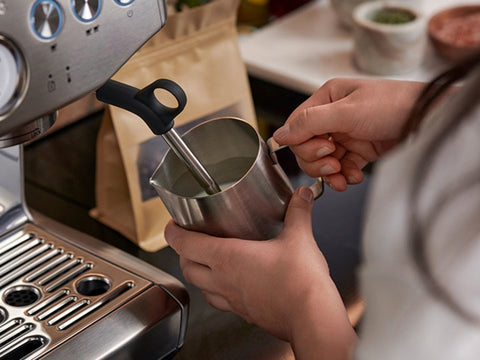
Milk Steaming & Frothing
The 360-degree swivel steam wand gives you excellent maneuverability for positioning your milk pitcher. The manual steam control (a simple dial) is intuitive: turn clockwise for steam, counterclockwise to stop. No complicated button sequences or confusing interfaces.
Steam Wand Performance
The steam power is good for a single-boiler home machine. You can steam 8-12 ounces of milk in 30-60 seconds, depending on starting temperature and desired final texture. This is adequate for home use but notably less powerful than dual-boiler machines or dedicated commercial steamers.
The wand produces enough pressure to create proper microfoam with the right technique. You can achieve velvety, glossy texture suitable for latte art, though it requires practice and attention. The steam isn't hands-off or forgiving—you need to engage with the process.
Microfoam Quality
With proper pitcher positioning and technique, you can create café-quality microfoam. The key is starting with cold milk, maintaining proper wand depth, and listening for the signature paper-tearing sound that indicates proper air incorporation.
Latte art is absolutely possible with the Barista Express, as countless YouTube videos and Instagram posts demonstrate. However, your skill matters more than the machine's capabilities. Expect a learning curve similar to dialing in espresso.
Single Boiler Reality
The Barista Express uses a single thermocoil for both brewing and steaming, meaning you cannot brew espresso and steam milk simultaneously. After pulling your shot, the machine needs roughly 10-15 seconds to heat from brewing temperature to steam temperature.
For most home users making one or two drinks, this is perfectly fine. Pull your shot into a preheated cup (the top of the machine functions as a cup warmer), then switch to steam mode while the espresso waits. By the time you've steamed and poured milk, your total drink time is 5-7 minutes, which is reasonable for morning routine.
If you're regularly making four or more milk drinks back-to-back, the single boiler becomes more noticeable. You'll wait between each drink for temperature transitions. This is where dual-boiler machines costing $1,500+ show their advantage. For typical home use, it's a non-issue.
Espresso Machine Comparison
| Feature | Barista Express | Dual Boiler |
|---|---|---|
| Simultaneous Brew/Steam | No | Yes |
| Steam Power | Good | Excellent |
| Heat-up Time | ~2 minutes | ~10-15 minutes |
| Recovery Between Drinks | 10-15 seconds | Instant |
| Price | $700 | $1,500+ |
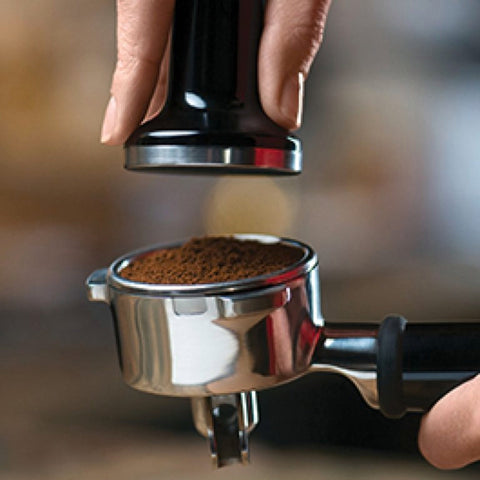
User Experience & Daily Living
Morning Routine Reality
Here's what making espresso looks like on a typical morning with the Barista Express:
- Turn on machine (0:00)
- While heating, grind beans into portafilter (0:30-1:00)
- Distribute grounds, tamp, and lock in portafilter (1:00-1:30)
- Machine ready light illuminates (2:00)
- Pull espresso shot (2:00-2:30)
- Switch to steam mode (2:30-2:45)
- Steam milk (2:45-3:30)
- Clean steam wand, enjoy drink (3:30-5:00)
Total time from power-on to finished latte: approximately 5-7 minutes. Once you develop muscle memory and routine, this becomes faster. The process is meditative rather than burdensome—many users report enjoying the ritual as much as the coffee.
Cleaning & Maintenance
The Barista Express makes maintenance straightforward, which is crucial for longevity.
Daily tasks (2-3 minutes):
- Wipe steam wand immediately after each use
- Empty drip tray when full (it has a float indicator)
- Knock out used pucks into knock box
- Rinse portafilter and baskets
- Wipe exterior if needed
Weekly tasks (10-15 minutes):
- Backflush with cleaning tablet using included cleaning disc
- Clean grinder burrs (remove top burr, brush away grounds)
- Deep clean steam wand tip
- Clean group head gasket with brush
Monthly tasks (20 minutes):
- Descale machine using Breville descaling solution or citric acid
- Replace water filter (included, change every 2 months)
- Deep clean everything
The cleaning cycle is genuinely easy. The machine prompts you when cleaning is needed, and the process is well-documented in the manual and countless YouTube videos. Maintenance is simpler than many competing machines because the design anticipates real-world home use.
Longevity & Reliability
With proper maintenance, most users report 3-5 years of daily use before experiencing any issues. Some get 7-10 years, while others encounter problems after 2 years. The variables: water hardness (use filtered water!), cleaning frequency, and usage volume.
Common issues after extended use include:
- Grinder motor wearing out (often after 5+ years)
- Group head gasket needing replacement (easy DIY fix)
- Steam wand tip clogging (preventable with proper cleaning)
- Water pump wearing out (typical for vibration pumps)
Breville's warranty covers one year for the Barista Express (two years for higher-end models like the Barista Pro). Extended warranty options are available through many retailers.
Replacement parts are widely available and relatively affordable due to the machine's popularity. The large user community means troubleshooting guides, YouTube tutorials, and forum support are abundant.
Real user testimonial: "I've had my Barista Express for 6 years with daily use. The grinder finally needed replacement last year, but otherwise it's been rock solid. Best $700 I've spent on a kitchen appliance."

Comparison: Barista Express vs Competitors
vs Breville Barista Touch ($999, often $799-899 on sale)
The Barista Touch adds significant automation and a modern touchscreen interface:
Barista Express vs Barista Touch
| Feature | Barista Express | Barista Touch |
|---|---|---|
| Heat-up Time | ~2 minutes | 3 seconds (ThermoJet) |
| Interface | Analog buttons/dials | Color touchscreen |
| Milk Frothing | Manual steam wand | Automatic with temp/texture control |
| Grind Settings | 16 settings | 30 settings |
| Pre-programmed Drinks | No | 8 customizable presets |
| Shot Control | Manual buttons | Touchscreen guided |
| Learning Curve | Moderate | Easy |
| Price | $699 | $999+ ($799-899 on sale) |
| Warranty | 1 year | 2 years |
Key differences:
- Touchscreen: The Touch features an intuitive color display that guides you through every step
- Automatic milk frothing: Set temperature (104-167°F) and texture level, and the wand does the work
- Faster heat-up: ThermoJet system heats in 3 seconds vs 2 minutes
- More automation: Pre-programmed café drinks and customizable presets
- Better warranty: 2 years vs 1 year
The espresso quality is virtually identical. Both use the same 54mm portafilter system, PID temperature control, and produce excellent shots.
Our take: The Barista Touch is worth the extra $200-300 if:
- You want automatic milk frothing (huge time-saver for beginners)
- The touchscreen interface appeals to you
- You're making multiple different drinks (latte, cappuccino, flat white) and want presets
- The 3-second heat-up matters for your morning routine
Stick with the Barista Express if:
- You want to learn traditional barista techniques
- Manual control appeals more than automation
- Budget is important ($200-400 savings)
- You prefer analog controls over touchscreens
vs Gaggia Classic Pro ($449)
The Gaggia Classic Pro is beloved by modders and enthusiasts:
- Gaggia: No grinder, more manual, highly moddable
- Barista Express: All-in-one, PID included, beginner-friendly
If you buy the Classic Pro, you'll need a separate grinder ($200-500), potentially a PID mod ($150+), and more patience learning. Total investment ends up similar or higher than the Barista Express, but you get a more traditional Italian machine that can be upgraded indefinitely.
Choose Classic Pro if you want a project machine and tinkering appeals to you. Choose Barista Express if you want to make coffee, not modify machines.
vs Breville Bambino Plus ($499)
The Bambino Plus is compact, fast, and features automatic milk frothing:
- Bambino: No grinder, automatic milk frother, 3-second heat-up, compact footprint
- Barista Express: Built-in grinder, manual steam wand, 2-minute heat-up, larger
FeatureBarista ExpressBambino PlusGrinderBuilt-in conical burrNone (need separate)Milk FrothingManual steam wandAutomatic with presetsHeat-up Time~2 minutes3 secondsLearning CurveModerateEasyPrice$699$499Total Setup Cost$699$899+ (need $200-400 grinder)
Different target audiences. Bambino suits people who want speed, convenience, and automatic milk frothing but already own a quality grinder. Barista Express suits people wanting all-in-one convenience and willing to learn manual techniques.
The math: If you need to buy a grinder separately for the Bambino ($200-400), your total investment ($699-899) equals or exceeds the all-in-one Barista Express ($699). The Express saves money AND counter space.
Both machines available at Everyday People Coffee & Tea
Quick Decision Matrix
Choose Barista Express if:
- You want all-in-one convenience
- Learning real barista skills appeals to you
- Budget is $700-800
- Counter space is limited (vs separate grinder + machine)
- You value the ritual of making coffee
- You don't already own a quality grinder
Choose something else if:
- You already own a quality grinder ($300+) - save money, get Bambino Plus or Gaggia Classic Pro
- You want one-button automation - get super-automatic
- Budget is under $500 total - save up or consider entry-level options
- You're a tinkerer wanting to mod - get Gaggia Classic Pro
- Speed is critical - get Barista Pro or Bambino Plus
Honest Pros & Cons
What We Love ✅
Exceptional value for all-in-one package At $700 (often $600 on sale), you get a genuine espresso machine plus grinder that would cost $900+ if purchased separately.
PID temperature control This feature is rare at this price point and crucial for consistent, balanced espresso.
Professional 54mm portafilter The quality portafilter feels substantial and produces proper espresso, not the thin substitute from pod machines.
Built-in grinder saves space and money One countertop footprint instead of two, and you're not spending $300-500 on a separate grinder.
Pressure gauge for visual feedback Invaluable learning tool that helps beginners understand extraction in real-time.
Solid build quality that lasts Metal construction throughout—this feels like equipment that will last with proper care.
Great accessory package included Everything you need to start making espresso except beans and milk.
Huge community support and resources Millions of users worldwide means abundant tutorials, troubleshooting guides, and community wisdom.
Easy to find replacement parts The popularity means parts availability and third-party accessories are excellent.
What Could Be Better ❌
Grinder is good, not great Adequate for most users but will eventually become the limiting factor for serious enthusiasts.
Single boiler limits simultaneous brewing/steaming Can't pull shots and steam milk at the same time. Minor inconvenience for typical home use.
Two-minute heat-up time Not terrible, but the Barista Pro's three-second heat-up is noticeably more convenient.
54mm portafilter vs 58mm industry standard Not a performance issue, but limits you to 54mm accessories (though plenty exist).
Learning curve may frustrate absolute beginners This machine requires technique. If you want push-button coffee, look elsewhere.
Can be messy while learning Ground coffee ends up on the counter during your first weeks of use.
Steam power adequate but not powerful Takes 45-60 seconds to steam milk vs 30 seconds on more powerful machines.
Is It Worth It in 2025? Final Verdict
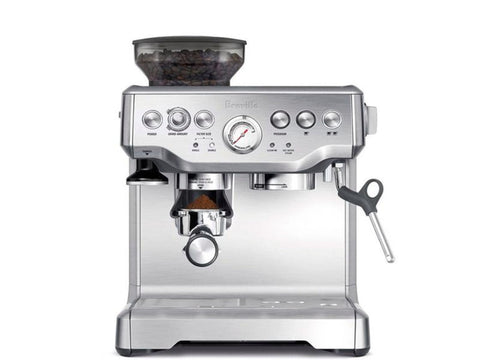
The 2025 Perspective
Newer models exist, but none offer better VALUE. The Barista Pro is faster but costs $200 more for essentially the same espresso quality. The Barista Express Impress adds automatic tamping and assisted dosing for $150 more—nice conveniences but not game-changers.
The fundamentals haven't changed: fresh beans, proper grind, correct dose, even tamping, stable temperature, and appropriate pressure. The Barista Express delivers all of these at an accessible price point.
Final Recommendation:
If you're ready to learn real espresso-making skills and want an all-in-one solution that won't limit you for years, the Barista Express remains the gold standard in 2025. It's not perfect, it's not the absolute best espresso machine, but at $699 it's the best combination of quality, features, value, and learning potential you can buy.
Frequently Asked Questions
Is the Breville Barista Express good for beginners?
Yes, with an important caveat: "beginner-friendly" doesn't mean "no learning required." The double-wall filter baskets help beginners get decent shots while learning, and the pressure gauge provides real-time visual feedback. The included accessories and comprehensive manual guide you through the process.
However, if you want a machine where you press a button and walk away, look at super-automatic machines instead. The Barista Express is for beginners who WANT to learn espresso technique, not bypass it.
How long does the Breville Barista Express last?
With proper maintenance—regular descaling every 1-2 months, backflushing weekly, and daily cleaning—expect 3-5 years of daily use. Some users report 7-10 years, while others experience issues after 2 years.
The key factors affecting longevity:
- Water hardness: Use filtered water to prevent scale buildup
- Cleaning frequency: Follow the recommended maintenance schedule
- Usage volume: Making 2 drinks daily vs 8 affects wear
The grinder typically wears out before the espresso components. Many long-term owners replace or upgrade the grinder around year 5-6 while continuing to use the espresso machine.
Can I use pre-ground coffee instead of the built-in grinder?
Yes! You can completely bypass the grinder and use pre-ground coffee or grounds from a separate grinder. Simply remove the portafilter, add grounds directly, and proceed as normal.
This is actually a great feature if you later upgrade to a better standalone grinder. You're not locked into using the integrated grinder. Many experienced users follow this upgrade path: start with the integrated grinder, then invest in a Baratza Sette 270 or Niche Zero later while continuing to use the Barista Express for espresso extraction.
What's the difference between Barista Express and Barista Pro?
The main differences:
- Heat-up time: Pro = 3 seconds, Express = 2 minutes
- Display: Pro has LCD with shot timer, Express has analog controls
- Grind settings: Pro has 30, Express has 16
- Price: Pro costs $200 more ($899 vs $699)
The espresso quality is virtually identical. The Pro offers convenience features (faster heat-up, more grind settings, digital display) but doesn't make better espresso. Buy the Pro if speed and modern interface matter to you. Save $200 with the Express if two-minute heat-up is acceptable.
Do I need to buy any accessories?
The machine comes well-equipped for getting started. However, these upgrades are popular among users:
Recommended upgrades (total: $85-150):
- Better tamper ($20-50): The included magnetic tamper works but a quality tamper improves consistency
- Bottomless (naked) portafilter ($30-40): Allows you to diagnose extraction issues visually
- IMS precision basket ($20-30): More uniform holes than stock baskets
- Dedicated knock box ($15-30): Makes disposing of pucks cleaner and easier
These are optional, not required. Many users happily use stock accessories for years.
Is 54mm portafilter a problem?
Not really. While the industry standard is 58mm (used in commercial machines), the 54mm works perfectly fine for home use. The difference in espresso quality is negligible—extraction principles remain the same.
Thanks to the Barista Express's massive popularity, 54mm accessories are widely available: bottomless portafilters, precision baskets, and replacement parts are easy to find. You're not locked into obscure sizing.
The 54mm vs 58mm debate matters more to enthusiasts than actual espresso quality. Focus on proper technique, fresh beans, and good water—these variables affect your espresso far more than portafilter diameter.
Can you make good latte art with the Barista Express?
Absolutely! The steam wand is capable of producing microfoam suitable for latte art. Countless YouTube videos and Instagram posts demonstrate latte art created with the Barista Express.
However, the machine is only half the equation. Latte art requires:
- Proper milk steaming technique (correct wand depth and positioning)
- Fresh, cold milk (whole milk works best for learning)
- Properly extracted espresso with good crema
- Pouring technique and practice
Expect a learning curve. Your first attempts won't look Instagram-worthy, but with practice (30-50 attempts), most users can create basic patterns like hearts and tulips. Advanced designs require even more practice.
Search "Barista Express latte art tutorial" on YouTube for excellent guidance.
How does it compare to machines 2-3x the price?
Machines costing $1,500-2,000+ offer improvements in:
- Temperature stability: Even more precise (though the Express is already quite good)
- Steam power: Noticeably stronger, faster milk steaming
- Build quality: Commercial-grade components, larger boilers
- Grinder precision: Better particle distribution (if built-in grinder included)
- Dual boilers: Simultaneous brewing and steaming
However, the espresso quality difference is smaller than the price difference suggests. The Barista Express represents a point of diminishing returns. You'll get improvements spending more, but they're incremental rather than transformational.
For home use, the Barista Express delivers 85-90% of the quality of machines costing twice as much. Whether that final 10-15% improvement is worth $800-1,300 more depends on your budget and enthusiasm level.
Should I buy refurbished or wait for sales?
Both strategies can save money:
Sales timing:
- Black Friday / Cyber Monday: Expect $50-150 off
- Amazon Prime Day: Similar discounts
- Holiday seasons: November-December often see deals
Refurbished options:
- Breville's official refurbished units come with warranty
- Typically $100-150 cheaper than new
- "Refurbished" often means customer returns with minimal use
- Same performance as new, just repackaged
Our recommendation: If you need the machine now, buying refurbished from Breville directly is a smart move. If you can wait, Black Friday offers the best discounts. Avoid third-party refurbished units without warranty.
Can I connect it to a water line?
No, the Barista Express requires manual water tank filling. The 67oz tank is removable for easy filling at the sink.
For plumbed-in (direct water line connection) options, you'll need to look at commercial-grade machines or high-end prosumer models starting around $2,000+. For home use, manual filling is standard and not particularly burdensome—you'll refill every 15-20 shots.
Getting Started: Your First Week
Day 1: Setup and First Shot
Before pulling your first shot:
- Run water through the system: Fill the tank, run hot water through the group head and steam wand to flush the system
- Season the grinder: Grind and discard the first 20-30 grams to clear manufacturing oils
- Install water filter: Follow instructions in the manual—this extends machine life significantly
- Preheat everything: Run blank shots (no coffee) to heat up the portafilter and group head
First shot checklist:
- Use fresh, quality beans (ideally roasted within 2-4 weeks)
- Start with grind setting 5 (middle range)
- Use the double-wall filter basket initially
- Aim for 18g coffee in, 36g liquid out, in 25-30 seconds
- Watch the pressure gauge—aim for the espresso range
Your first shot probably won't be perfect. That's completely normal and expected.
Days 2-7: Dialing In
Each coffee requires dialing in—adjusting grind size, dose, and time to achieve balanced extraction.
If your shot runs too fast (under 20 seconds):
- Grind finer (lower number on the dial)
- Increase dose slightly
- Ensure proper tamping pressure (30 pounds)
If your shot runs too slow (over 35 seconds):
- Grind coarser (higher number on the dial)
- Reduce dose slightly
- Check for channeling (uneven extraction)
Using the pressure gauge:
- Needle should enter the espresso range within 5-10 seconds
- Should stay in espresso range for most of extraction
- If it shoots into red zone immediately: grind is too fine
- If it never reaches espresso range: grind is too coarse
Take notes! Record your grind setting, dose, and results. This accelerates learning dramatically.
Week 2-4: Developing Consistency
By week two, you should be pulling decent shots regularly. Now focus on:
Workflow consistency:
- Same dose every time (weigh your coffee)
- Consistent tamping pressure
- Proper puck preparation (distribution matters)
- Clean portafilter between shots
Transitioning to single-wall baskets:
Once you can pull consistent shots with double-wall baskets, switch to single-wall. The flavor improvement is immediately noticeable—more clarity, better sweetness, cleaner finish.
Single-wall baskets are less forgiving but more rewarding. They show you exactly what's happening during extraction.
Milk steaming practice:
If you're making milk drinks, dedicate practice sessions to steaming:
- Use a thermometer initially (aim for 140-160°F)
- Practice finding the sweet spot for aeration (just below milk surface)
- Listen for the paper-tearing sound
- Keep wand tip positioned properly throughout
Water is cheaper than milk—practice steaming water first to understand wand positioning without wasting milk.
Advanced Tips for Better Results
Dialing In Different Roasts
Light roasts (fruity, acidic, tea-like):
- Grind slightly finer
- Higher temperature (use Express's default or slightly higher)
- May need longer extraction time (30-35 seconds)
- Expect brighter, more complex flavors
Medium roasts (balanced, chocolatey, nutty):
- Standard extraction parameters work well
- 25-30 seconds extraction time
- Default temperature perfect
- Most forgiving to dial in
Dark roasts (bold, bitter, full-bodied):
- Grind slightly coarser
- Lower temperature if possible (though Express doesn't offer easy temp adjustment)
- Shorter extraction time acceptable (20-25 seconds)
- Watch for over-extraction bitterness
Water Quality Matters More Than You Think
Bad water makes bad espresso, regardless of machine quality. Invest in:
Minimum: Use the included water filter and change every two months
Better: Use filtered water from a pitcher (Brita, etc.) plus the machine's filter
Best: Use third-wave water (commercially available) or make your own with distilled water plus mineral packets
Avoid distilled water alone—espresso needs minerals for proper extraction and flavor. Also avoid extremely hard tap water—it will scale your machine and taste mineral-heavy.
Common Mistakes to Avoid
Grinding stale beans: Beans lose peak flavor 4-6 weeks after roasting. Buy fresh, store properly in airtight container.
Skipping distribution: After grinding into portafilter, distribute grounds evenly before tamping. Channeling ruins extraction.
Inconsistent tamping: Tamp straight down with even pressure (about 30 pounds). Tilted tamping creates channels.
Dirty machine: Coffee oils go rancid. Clean group head, portafilter, and baskets daily. Backflush weekly.
Wrong dose: Using 15g in an 18g basket or 20g in an 18g basket affects extraction. Match dose to basket size.
Not preheating: Run blank shots to heat the portafilter and group head. Cold metal extracts poorly.
When to Upgrade Components
Immediate upgrades worth considering:
- Better tamper (stock magnetic tamper is functional but basic)
- Scale for weighing dose (consistency improves dramatically)
After 6 months when you understand the machine:
- Bottomless portafilter (diagnostic tool showing channeling)
- IMS precision basket (better hole pattern)
After 1-2 years if you've outgrown the grinder:
- Standalone quality grinder (Eureka Mignon, Baratza Sette 270, Niche Zero)
- Keep using Barista Express for espresso extraction
Troubleshooting Common Issues
Machine Won't Heat or Turn On
- Check power connection
- Ensure water tank is properly seated
- Try resetting by unplugging for 30 seconds
- Contact Breville support if issue persists
Weak or Watery Espresso
- Grind finer
- Increase dose
- Ensure proper tamping
- Check that you're using single-wall basket (not double-wall)
- Verify beans are fresh (under 6 weeks from roast date)
Bitter or Over-Extracted Shots
- Grind coarser
- Reduce extraction time
- Check water temperature
- Ensure you're not over-dosing the basket
- Verify beans aren't too dark or stale
Sour or Under-Extracted Shots
- Grind finer
- Increase extraction time to 25-30 seconds
- Ensure water is reaching proper temperature
- Check that dose is adequate
Grinder Jams or Makes Noise
- Check for foreign objects in hopper
- Remove top burr and clean thoroughly
- Ensure beans aren't oily (very dark roasts can gum up grinder)
- Run rice through grinder to clean (Breville-recommended method)
Steam Wand Won't Produce Steam
- Ensure machine has fully heated to steam mode
- Check steam tip isn't clogged (clean with pin if needed)
- Verify water tank has adequate water
- Run descaling cycle if machine is scaled up
Leaking from Portafilter
- Replace group head gasket (wears out over time)
- Ensure portafilter is locked in tightly
- Check that basket is properly seated
- Clean coffee grounds from gasket area
Pressure Gauge Not Entering Espresso Range
- Grind much finer
- Increase dose
- Check for channeling (uneven puck preparation)
- Ensure proper tamping pressure
Maintenance Schedule
Daily (2 minutes)
- [ ] Wipe steam wand immediately after each use
- [ ] Empty drip tray when indicator shows full
- [ ] Knock out used coffee pucks
- [ ] Rinse portafilter and baskets under hot water
- [ ] Wipe exterior surfaces
Weekly (15 minutes)
- [ ] Backflush with cleaning tablet
- [ ] Clean group head screen with brush
- [ ] Remove and clean grinder burrs
- [ ] Deep clean steam wand with soaking cleaner
- [ ] Wipe down entire machine thoroughly
Monthly (20 minutes)
- [ ] Descale machine (or every 2-3 months depending on water hardness)
- [ ] Replace water filter
- [ ] Check group head gasket condition
- [ ] Clean grinder chute and dosing area thoroughly
- [ ] Inspect all seals and gaskets
Every 6 Months
- [ ] Consider replacing group head gasket if shots are leaking
- [ ] Deep clean entire machine inside and out
- [ ] Check all moving parts for wear
- [ ] Evaluate grinder burr condition
Pro Maintenance Tips:
Use Breville-branded cleaning tablets and descaling solution—they're formulated specifically for their machines and won't void warranty.
Keep a maintenance log. Note when you backflushed, descaled, changed filters. This helps troubleshoot issues and ensures you don't miss critical maintenance.
If you have very hard water, descale more frequently. Test your water hardness with strips (available at hardware stores) to determine ideal descaling schedule.

Conclusion: A Decade Later, Still Remarkable
The Breville Barista Express has sold millions of units worldwide over its 10+ year production run for good reason: it democratized quality espresso. Before this machine, home baristas faced a stark choice: spend $300-400 on a basic machine that couldn't make real espresso, or spend $1,500+ on prosumer equipment.
The Barista Express carved out a middle ground that didn't exist before genuine espresso capability with skill-building potential at a price regular people could justify. At Everyday People Coffee & Tea, we've seen countless customers graduate from drip coffee makers to pulling café-quality shots at home with this machine.
In 2025, with countless competitors and even Breville's own newer models, the Barista Express remains the benchmark. Not because it's perfect, but because it gets the fundamentals right while making smart compromises that don't compromise the final product in your cup.
The verdict is simple: If you want to learn real espresso craft, want an all-in-one solution that won't limit your growth, and have a budget around $700, the Barista Express is still the answer. We stock it at Everyday People Coffee & Tea because after testing dozens of machines, this is the one we confidently recommend to aspiring home baristas.
Ready to start your home barista journey? The Barista Express remains the smart choice.
